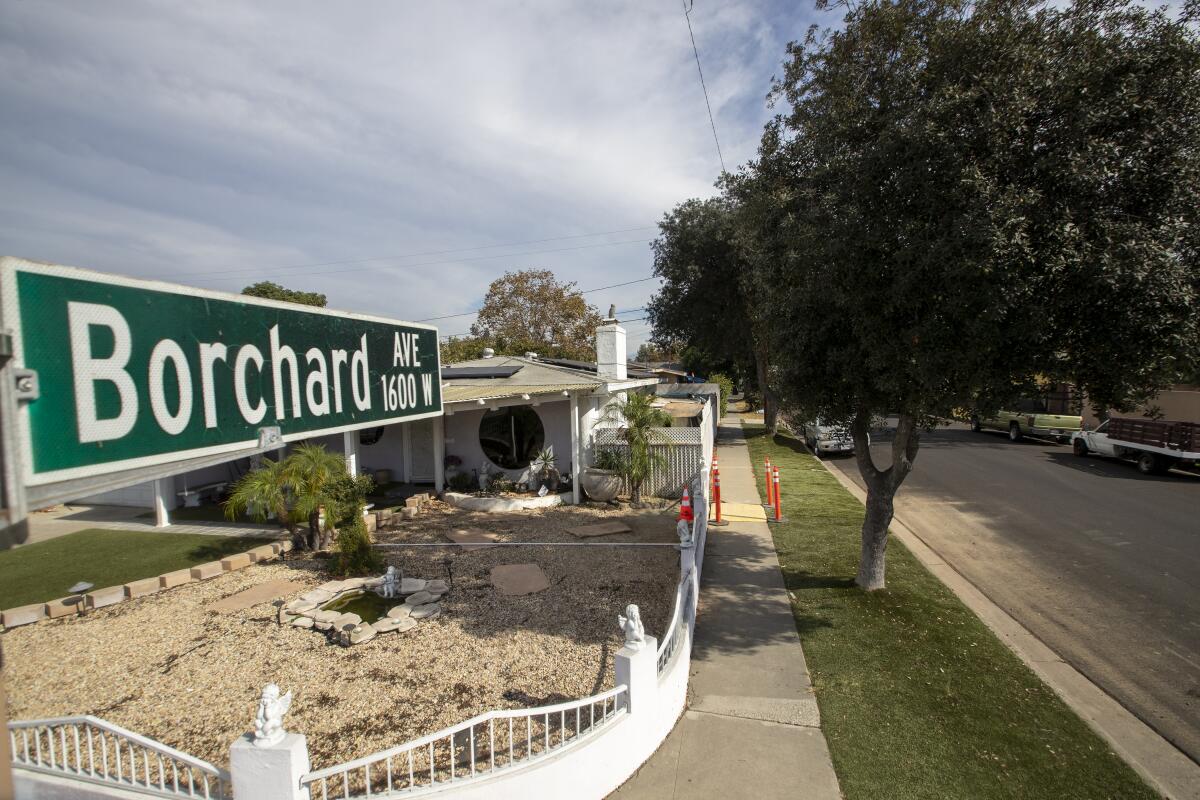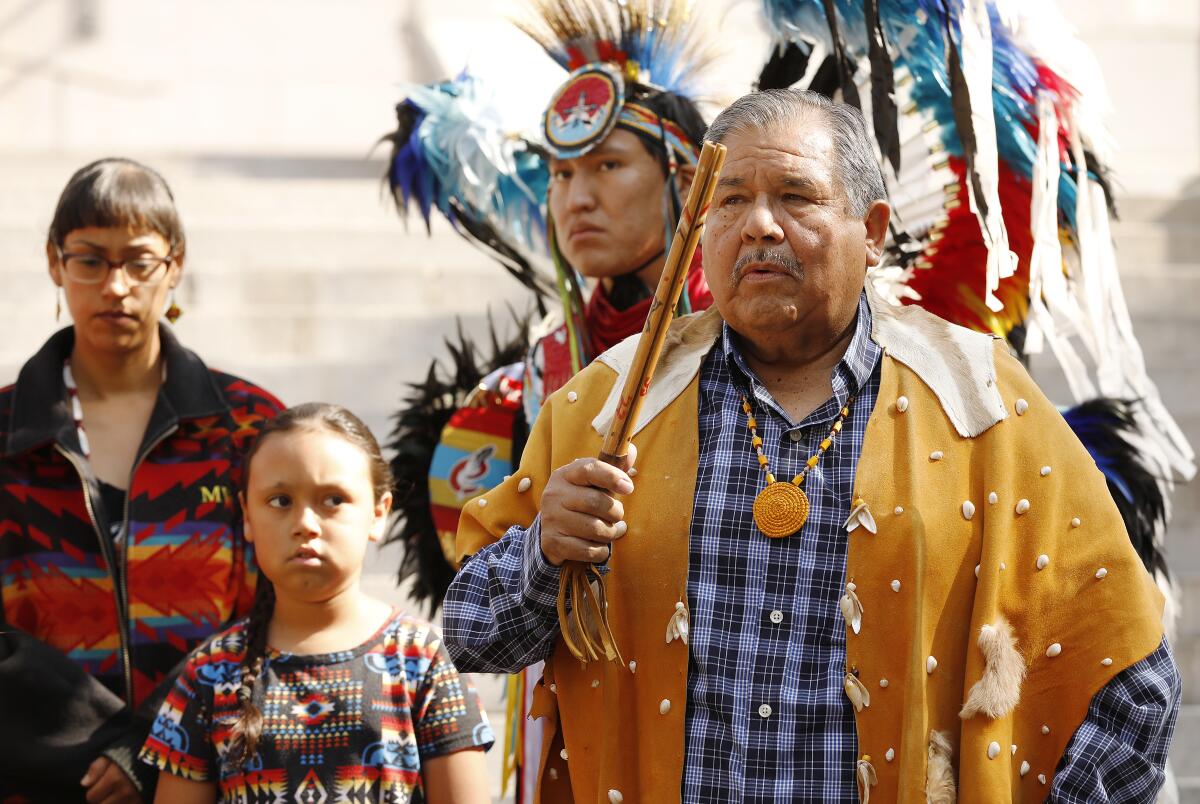Native American remains found in Santa Ana will receive ceremonial burial

- Share via
In a quiet residential neighborhood in Santa Ana, city workers were digging beneath a sidewalk when they made a startling discovery four feet deep — bones.
It appeared to be a complete human skeleton. Homicide detectives were summoned to the site in the 1600 block of West Borchard Avenue after the late October find.
But forensic investigators quickly determined that the bones were very old — at least 100 years old. And they appeared to be those of a Native American person, perhaps a member of the Gabrielino-Tongva tribe who once lived in the area.
A month earlier, about two miles from the Borchard Avenue site, crews excavating for the OC Streetcar project also found ancient Native American bones.
With work continuing on the 4.1-mile streetcar line, more ancient remains could be unearthed in a county that is synonymous with suburban sprawl yet built on layers of history, from the agricultural past that inspired its name to the hunter gatherers who were its first human inhabitants.
“It makes you wonder how many are under us every day,” said Sgt. Dennis Breckner, a spokesman for the Orange County Sheriff-Coroner Department.
The quest to find both sets of remains a final resting place began soon after they were identified as ancient and Native American.
As required by law, the Orange County Coroner Division notified the state Native American Heritage Commission within 24 hours.
The commission was then required to immediately contact the “most likely descendent” — often, a tribal representative or a tribe member with roots near where the remains were found.
In both the Santa Ana cases, the commission tapped Gabrielino-Tongva chief Anthony Morales as the descendent responsible for recommending a place and method of burial.
Similar finds are not uncommon in Orange County. But they are always emotionally jarring, Morales said. His ancestors buried their loved ones with no idea that suburbia would eventually rise on top of the graves.
“Once someone’s buried, they should be buried forever and never see the light of day,” said Morales, who is also known as Chief Red Blood. “So it’s kind of disturbing to us when we come across situations like this. But we have to take into consideration today, versus the past.”

A Tongva village is believed to have once stood on the area where both sets of remains were found. With the Santa Ana River nearby, it was a logical spot to settle, Morales said.
Morales will now work with local officials and an archaeologist to investigate the remains and the places where they were found.
Were they men or women? How old were they when they died? How long ago did they walk this land? Did they live in the village?
Both discoveries were made “in the heart of Tongva land,” said Desiree Martinez, a Tongva tribe member and archaeologist from Baldwin Park who specializes in working with local Indigenous tribes.
For at least 10,000 years, the Tongva lived in the Los Angeles Basin, northern Orange County and the Channel Islands, including Santa Catalina.
Spanish missionaries who arrived in the 18th century renamed them the Gabrieleño, now often spelled Gabrielino, forcing them to convert to Christianity, toil as slave laborers and adopt a European way of life.
Another tribe, the Acjachemen, referred to as the Juaneño by missionaries, lived in southern Orange County, Martinez said, with Aliso Creek dividing them from the Tongva.
Martinez said she knows a Tongva woman whose grandfather grew up near the OC Streetcar project site where the first set of remains was found. The woman’s uncle may have been buried near the second site.
“Making sure ancestors are treated with the utmost respect is the most important thing,” Martinez said. “If we had our druthers, we wouldn’t want the ancestor found or located or disturbed.”
In Southern California, construction projects have sometimes uncovered large burial grounds.
During freeway construction in Long Beach in the 1950s, workers found the bones of about 100 Native inhabitants. In 2016, more than a half-century later, the remains were reburied in the same area.
Members of the Gabrielino-Tongva tribe battled for years over almost 400 human remains exhumed during construction of a multibillion-dollar luxury housing project in Playa Vista.
During the legal battle, the remains and other artifacts rested in containers in a nearby trailer before returning to the earth under an agreement reached between tribe members and developers.
In Orange County in 2007, 164 Native American remains were found at a Huntington Beach construction site. Last fall in the county, some portions of the 405 Freeway widening project were delayed after workers came across ancient bones.
“Every orange grower, every green bean field operator, the Segerstrom family in South Coast Plaza, Caltrans, the freeways, anyone who’s dug in the oil industry — anyone who’s dug into the ground here — has ended up finding some aspects of Native American occupation,” said Paul Apodaca, former curator of the Bowers Museum in Santa Ana who is now a professor at Chapman University.
After all the questions that can be answered are answered, Morales will find a suitable place to bury the two sets of Santa Ana remains in a traditional ceremony, held in a secluded area and attended by a small group of tribe members.
“Through prayer, through song, through reburial — that’s our healing,” Morales said.
His ancestors’ rest, disturbed after decades under suburban pavement, will begin again — hopefully, this time, forever.
More to Read
Sign up for Essential California
The most important California stories and recommendations in your inbox every morning.
You may occasionally receive promotional content from the Los Angeles Times.














